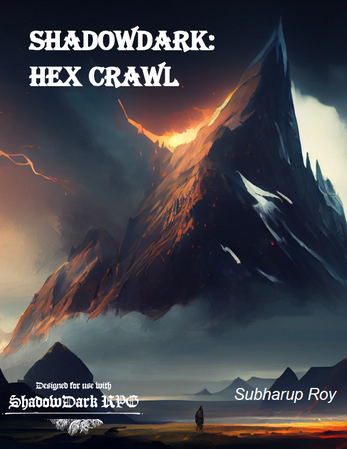Shadowdark Hex Crawl Rules
A downloadable game
What is a hex crawl?
Hex crawl games are ones where the players, often begin with a largely empty or partial map that is only some of the map (the shoreline of an island, a frontier town etc.) is filled. The map is formatted on a grid of hexagons, most of which begin blank. The gamemaster (GM) tells the players which hex they are starting in, usually one of the filled in sections. From there, it is up to the players. They point at the next hex, mapped or unmapped, that they plan to explore and hence starts an epic exploration campaign.
Why the need for hex crawl rules?
It is my belief that the explorative fantasy of being Marco Polo or David Livingstone is a prominent human desire. Think of Star Trek boldly going where no one has gone before or Indiana Jones travelling through strange jungles to find lost relics. The fantasy of being an explorer is well-represented in media the world over; it is tantalizing, vibrant, and fascinating. In “the world’s greatest roleplaying game”, the best way to simulate and bring to life the stories of our imaginations where we go through strange new lands, where every new mile brings new surprise, is by exploring an unknown part of the GM’s world hex by hex where each and every new space reveals a new surprise.
Design Principles
Now that we have established that exploration is a fantastic, pervasive aspect of gameplay, let us start with some of the basics of what you will need to design your next amazing adventure.
Define Party Roles
Having a specific role during travel and exploration will keep players engaged and give them some basic guidance about what they are supposed to do during the game.
Rewards in Every Hex
One of the biggest problems with many, even well-loved, hex crawls is that majority of the hexes do not have any point of interest. This results in play, where hex after hex goes by with a few uninteresting random encounters and nothing else. This, in turn, leads to player frustration that may cause them to start disengaging from the game.
To counter this problem, a GM must ensure that every hex has a point of interest – something unique that cannot be found in another hex. This task is not as daunting as it seems at first glance. It is perfectly acceptable to have two different tombs of dead tribal chieftains in two different hexes. Those just need to have different dungeon layouts and different inhabitants of each dungeon; it’s even better if distinct cultures for each of the tribes exists in the lore.
An important point here is that the GM should allow the players to pass through a hex without them finding the point of interest if they are unable to roll well or simply do not ask about it. This will make the environment feel alive and real. If the players must backtrack to a hex and they stumble upon a ruin that they had not found before, the world will be more realistic to them.
Resource Management
Wilderness exploration is about resource management. Sitting here at the end of the beginning of the twenty-first century, one can say with reasonable confidence that many RPG tables do not track resources meticulously, as the system comes up with many player- and GM-friendly ways around it. This is important to note as introducing a hex crawl will drastically change the approach to resource tracking. “How much water did you drink?” or “How many torches do we have left?” – these questions are of paramount importance for exploration games.
Distinctive Sessions of Time
Time slicing is the most powerful tool in a GM’s locker. That is to say, the GM controls how much time passes between any two moments. It can be as vague as, “A few weeks go by as you’re exploring this infernal jungle…” or as precise as “…as the velociraptor stares right back at you, you hear a sudden rustle of leaves to your right…” While it takes roughly the same time to utter the two sentences at the table, there’s a massive difference of passed time in the game world – time lost or gained, changing everything.
Similarly, for wilderness exploration (hex crawl or not), it is useful to think in chunks of time. The chunk could vary as much from four hours to a whole day, but you can apply the rules of the system presented here in the same way. How long should this chunk of time be? That depends on the type of game you are running.
| Status | Released |
| Category | Physical game |
| Author | The F-Bard |
| Tags | Exploration, Fantasy, Hexcrawl, shadowdark |
Purchase
In order to download this game you must purchase it at or above the minimum price of $3.99 USD. You will get access to the following files:

Leave a comment
Log in with itch.io to leave a comment.